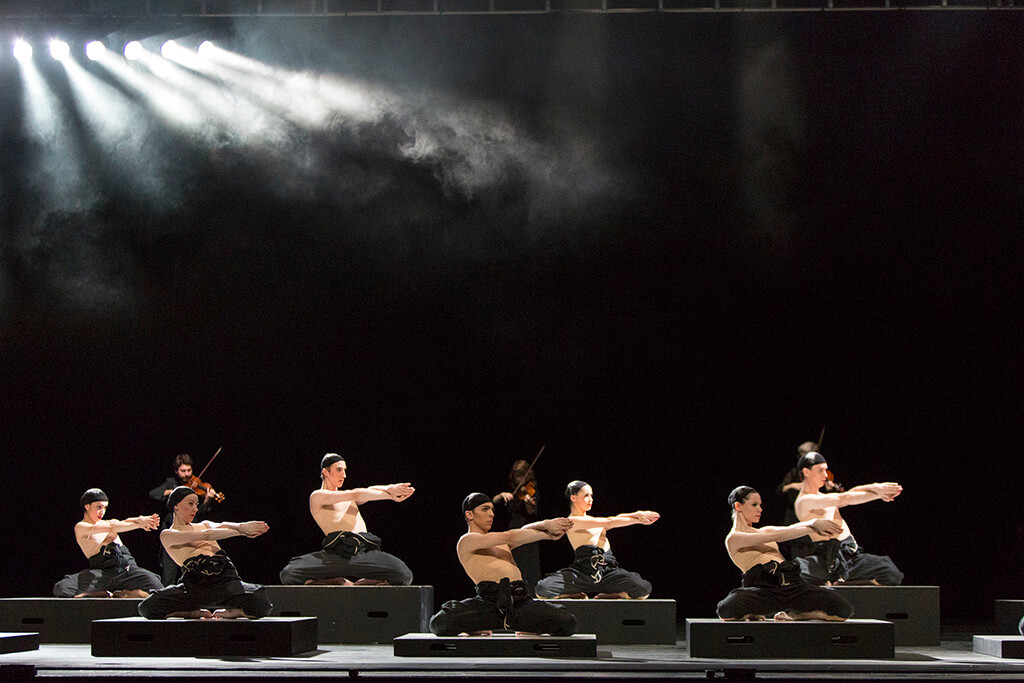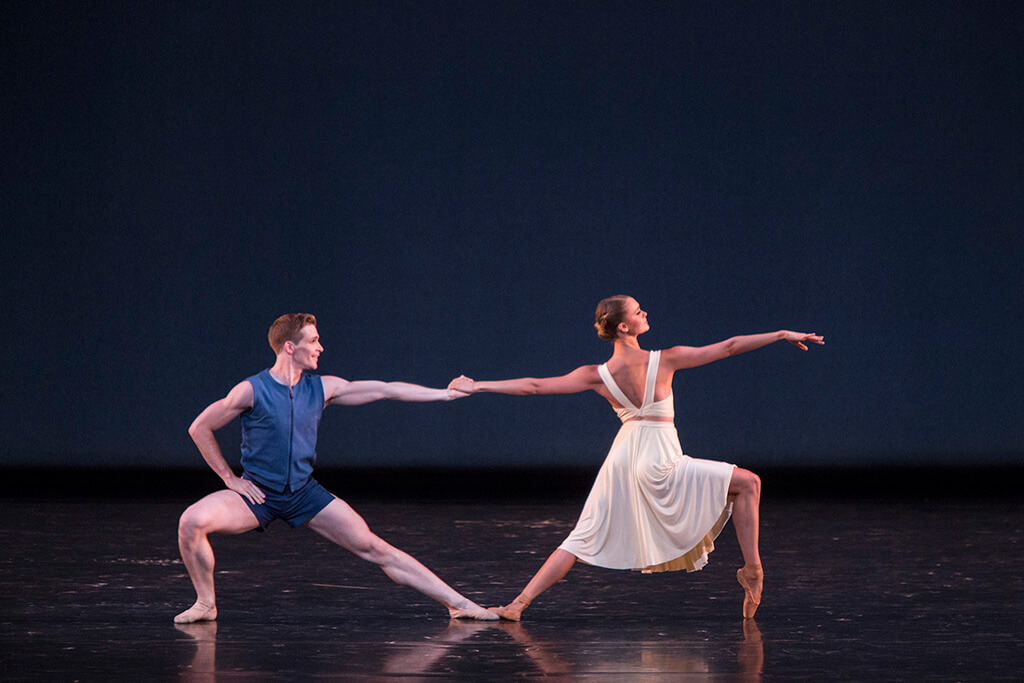
The National Ballet of Canada Summer Mixed Program (Paz de la Jolla, The Man in Black and Cacti, at the Four Seasons Centre, June 16 to 22. national.ballet.ca
The full-length story ballets are the big money-earners that put bums in seats, but to true blue ballet cognoscenti, it is the mixed programs that really show the mettle of a company. The National Ballet of Canada’s summer mixed program is a perfect example of challenging dance represented by a range of choreographic styles.
Every mixed program should have a new work, and for this concert, the premier is Justin Peck’s Paz de la Jolla. Peck, a New York City Ballet dancer and resident choreographer, just won the Tony Award for Best Choreography for the revival of Rodgers and Hammerstein’s Carousel. To say Peck is currently riding high in dance circles is a given.
You don’t have to read the program notes to instantly divine that Paz de la Jolla (2013) is about youth and joy and young love, all bathed in sunshine (courtesy of lighting designer Mark Stanley). Reid Bartelme and Harriet Jung’s gorgeous costumes are a compilation of beach sportswear, from bathing suits, to halter-tops and shorts, and everything in between. The stage is literally alive with colour. In fact, Peck created the work for his home company as an homage to the southern California beach life of his youth. The only thing missing are the surfboards.
Choreographically speaking, Peck is a son of Balanchine, the legendary founder of New York City Ballet. For this work, Peck has adopted a Balanchine-like format by opting for a lead ballerina (first soloist Chelsy Meiss) and a couple (first soloist Hannah Fischer and principal dancer Harrison James), as the dominant dancers surrounded by a 15-member corps de ballet. Like Balanchine, Peck has fashioned quirky, mercurial movement of his own that translates into flat-out dancing, and Meiss, as queen of the beach, never seems to slow down. Both she and the corps execute non-stop, intricate footwork and arm gestures in all directions, not to mention many turns and jumps along the way. Vigorous and energetic are good words to describe the dizzying peregrinations happening on the stage. As for Meiss, she once again shows her mastery of difficult technique, which she tosses off with seeming ease.

Fischer and James are on a different journey. During the ballet, they meet, fall in love, lose each other, and come together again. While they do perform with the corps from time to time, they have their own pas de deux showing the arc of their relationship. For them, Peck has crafted long, languorous movement that entwines their bodies, along with lifts that are like an embrace. As an interesting costume note, one of the couple’s pas de deux is performed against a backdrop of the slowly moving corps de ballet garbed in diaphanous grey jackets that wash out the bright colours of their outfits. This highlights the couple’s distancing themselves from the crowd.
With apologies to Harrison, who is an excellent dancer and cuts a handsome, romantic figure on stage, he is eclipsed by the captivating Fischer. You cannot take your eyes off her. Unlike the casually clad others, she is in a stylish, cream-coloured dress, which sets her apart. She is lady-like and sweet and innocent and elegant, totally unlike the rambunctious crew around her. Her every movement conveys precise placement cocooned with lyrical grace. Fischer truly is beauty in motion, and a major star in the making.
The score Peck has chosen is a clever play on words, given the title of the ballet, and music director/conductor David Briskin, pianist Andrei Streliaev, and the ballet orchestra rendered an even, almost reverential reading of Martinu’s Sinfonietta la Jolla. For me, however, there is a bit of a disconnect between the dance and the music. Martinu’s composition conveys the same, sombre underlay that marks, for example, Vaughan Williams’ music, (dare I say turgid?), and while the Sinfonietta does provide Peck with the fast and slow parts that he needs, Martinu just isn’t perky enough. As for the Paz de la Jolla as a whole, it is an attractive, uncomplicated dance, and while conveying nothing new or earthshattering in terms of choreography, the ballet is an enjoyable opening to any program.
The other two pieces are part of the National’s repertoire. Cacti (2010) by Swedish choreographer Alexander Ekman debuted in 2016, while The Man in Black (2010) by Canada’s own James Kudelka was first performed by the National in 2011.
Cacti has Europe written all over it, given its iconoclastic, clever, sophisticated, off-the-wall insouciance. This next statement may create howls among North American ballet fans, but New World choreographers are simply not as urbane, or as cynical, or as jaded as those from Europe, nor would we want them to be. Cacti’s main purpose is to take a pot shot at pompous contemporary dance trends and, alas, at the reviewers who write about them.
The piece begins with a wickedly droll voice-over text by Spenser Theberge, opining in a most ponderous fashion about the disengagement between native rituals and modern-day dance, or some such theory. In truth, the ideas are buried in an avalanche of overblown words, and that is Ekman’s intention. Midway through the piece, the voice-over returns with a hilarious review of the ballet thus far, discussing symbolism and meaning, and the like. For a reviewer, it is a cringe-worthy moment to hear our earnest selves so cleverly parodied.
In between, the 16 dancers, each on individual wooden platforms, perform bizarre body and arm movements that end with posing in the most unlikely, silly positions. Later in the piece they each bring a cactus plant onstage, and later still, create a large, helter-skelter sculpture out of their platforms. (It is the meaning of the sculpture and the presence of the cacti that the voice-over reviewer addresses.) We are also treated to two dancers (first soloist Jordana Daumec and second soloist Félix Paquet) coaching each other through a dance number, ably abetted by a humorous voice-over dialogue.
To add to the pretentiousness, there is an onstage string quartet, who along with the orchestra, perform a compendium of music by Haydn, Beethoven, Schubert, Mahler, and someone called Andy Stein. A quintet of musicians is credited with the “assembly, improvising and composing” of the compilation. The second part of the work, after the faux review, is all music by Schubert. Incidentally, the orchestra for Cacti was under the helm of guest conductor Geneviève Leclair, who negotiated through the score in sprightly fashion. It’s always good news to see a woman in the pit.
Cacti earned genuine giggles from the audience, and deservedly so, and, as the choreographer intended, by the end of the piece, you do realize that the platform sculpture and the cacti mean absolutely nothing.
If the National’s artistic director, Karen Kain, programmed The Man in Black every season, I would be a happy camper. Every time the piece is performed, the audience stands and cheers, and for good reason. The Man in Black is a genuine Canadian classic and a Kudelka masterpiece. I’ve seen the piece at least ten times, and I still find more and more layers to the choreography.
The score is made up of six, mostly “hurtin’” songs, (including Four Strong Winds by Ian Tyson and If You Could Read My Mind by Gordon Lightfoot), recorded by the legendary Johnny Cash near the end of his career. At this point, his deep, gravely voice was a shadow of its former self, which makes the choreography all the more poignant. This piece about a man looking back on his life touches the soul.
Four dancers (first soloist Francesco Gabriele Frola, principal character artist Stephanie Hutchison, and corps members Kota Sato and Ethan Watts), garbed in western gear and cowboy boots, perform a heart-breaking fusion of western-style dance such as line and step, and movement that conveys the story and/or the emotional underpinnings of each song. This quartet of dancers, in particular, brings to life the tension that is fraught within the fibre of the work. Frola is a stand-out, because he is the outlier among the four, and to him, falls the most-angst ridden movement.
Kudelka’s choreography is brilliantly subtle. Even simple things such as the way the dancers are attached to each other, and in what direction each faces, speak volumes about their relationship as driven by the lyrics. The piece ends in deep sorrow. During Bruce Springsteen’s Further On Up The Road, one by one the men disappear from the stage, leaving Hutchison performing a lonely step dance in a slowly dimming spotlight.
- INTERVIEW | Actor Diego Matamoros Takes On Icon Walt Disney In Soulpepper Production Of Hnath Play - April 16, 2024
- SCRUTINY | Opera In Concert Shine A Light On Verdi’s Seldom Heard La Battaglia Di Legnano - April 9, 2024
- SCRUTINY | Lepage & Côté’s Hamlet Dazzles With Dance And Stagecraft Without Saying Anything New - April 5, 2024



